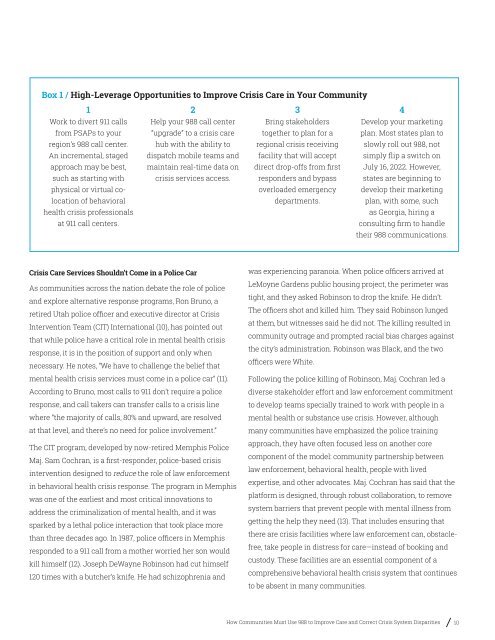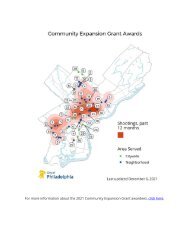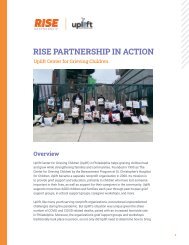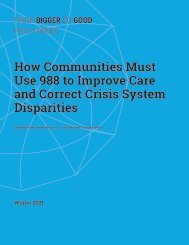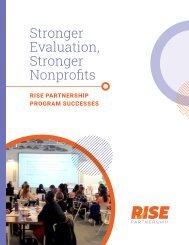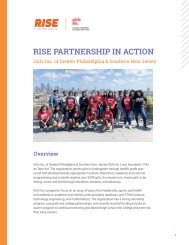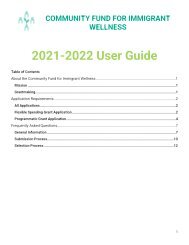How Communities Must Use 988 to Improve Care and Correct Crisis System Disparities
You also want an ePaper? Increase the reach of your titles
YUMPU automatically turns print PDFs into web optimized ePapers that Google loves.
Box 1 / High-Leverage Opportunities <strong>to</strong> <strong>Improve</strong> <strong>Crisis</strong> <strong>Care</strong> in Your Community<br />
1<br />
2<br />
3<br />
4<br />
Work <strong>to</strong> divert 911 calls<br />
Help your <strong>988</strong> call center<br />
Bring stakeholders<br />
Develop your marketing<br />
from PSAPs <strong>to</strong> your<br />
“upgrade” <strong>to</strong> a crisis care<br />
<strong>to</strong>gether <strong>to</strong> plan for a<br />
plan. Most states plan <strong>to</strong><br />
region’s <strong>988</strong> call center.<br />
hub with the ability <strong>to</strong><br />
regional crisis receiving<br />
slowly roll out <strong>988</strong>, not<br />
An incremental, staged<br />
dispatch mobile teams <strong>and</strong><br />
facility that will accept<br />
simply flip a switch on<br />
approach may be best,<br />
maintain real-time data on<br />
direct drop-offs from first<br />
July 16, 2022. <strong>How</strong>ever,<br />
such as starting with<br />
crisis services access.<br />
responders <strong>and</strong> bypass<br />
states are beginning <strong>to</strong><br />
physical or virtual co-<br />
overloaded emergency<br />
develop their marketing<br />
location of behavioral<br />
departments.<br />
plan, with some, such<br />
health crisis professionals<br />
as Georgia, hiring a<br />
at 911 call centers.<br />
consulting firm <strong>to</strong> h<strong>and</strong>le<br />
their <strong>988</strong> communications.<br />
<strong>Crisis</strong> <strong>Care</strong> Services Shouldn’t Come in a Police Car<br />
As communities across the nation debate the role of police<br />
<strong>and</strong> explore alternative response programs, Ron Bruno, a<br />
retired Utah police officer <strong>and</strong> executive direc<strong>to</strong>r at <strong>Crisis</strong><br />
Intervention Team (CIT) International (10), has pointed out<br />
that while police have a critical role in mental health crisis<br />
response, it is in the position of support <strong>and</strong> only when<br />
necessary. He notes, “We have <strong>to</strong> challenge the belief that<br />
mental health crisis services must come in a police car” (11).<br />
According <strong>to</strong> Bruno, most calls <strong>to</strong> 911 don’t require a police<br />
response, <strong>and</strong> call takers can transfer calls <strong>to</strong> a crisis line<br />
where “the majority of calls, 80% <strong>and</strong> upward, are resolved<br />
at that level, <strong>and</strong> there’s no need for police involvement.”<br />
The CIT program, developed by now-retired Memphis Police<br />
Maj. Sam Cochran, is a first-responder, police-based crisis<br />
intervention designed <strong>to</strong> reduce the role of law enforcement<br />
in behavioral health crisis response. The program in Memphis<br />
was one of the earliest <strong>and</strong> most critical innovations <strong>to</strong><br />
address the criminalization of mental health, <strong>and</strong> it was<br />
sparked by a lethal police interaction that <strong>to</strong>ok place more<br />
than three decades ago. In 1987, police officers in Memphis<br />
responded <strong>to</strong> a 911 call from a mother worried her son would<br />
kill himself (12). Joseph DeWayne Robinson had cut himself<br />
120 times with a butcher’s knife. He had schizophrenia <strong>and</strong><br />
was experiencing paranoia. When police officers arrived at<br />
LeMoyne Gardens public housing project, the perimeter was<br />
tight, <strong>and</strong> they asked Robinson <strong>to</strong> drop the knife. He didn’t.<br />
The officers shot <strong>and</strong> killed him. They said Robinson lunged<br />
at them, but witnesses said he did not. The killing resulted in<br />
community outrage <strong>and</strong> prompted racial bias charges against<br />
the city’s administration. Robinson was Black, <strong>and</strong> the two<br />
officers were White.<br />
Following the police killing of Robinson, Maj. Cochran led a<br />
diverse stakeholder effort <strong>and</strong> law enforcement commitment<br />
<strong>to</strong> develop teams specially trained <strong>to</strong> work with people in a<br />
mental health or substance use crisis. <strong>How</strong>ever, although<br />
many communities have emphasized the police training<br />
approach, they have often focused less on another core<br />
component of the model: community partnership between<br />
law enforcement, behavioral health, people with lived<br />
expertise, <strong>and</strong> other advocates. Maj. Cochran has said that the<br />
platform is designed, through robust collaboration, <strong>to</strong> remove<br />
system barriers that prevent people with mental illness from<br />
getting the help they need (13). That includes ensuring that<br />
there are crisis facilities where law enforcement can, obstaclefree,<br />
take people in distress for care—instead of booking <strong>and</strong><br />
cus<strong>to</strong>dy. These facilities are an essential component of a<br />
comprehensive behavioral health crisis system that continues<br />
<strong>to</strong> be absent in many communities.<br />
<strong>How</strong> <strong>Communities</strong> <strong>Must</strong> <strong>Use</strong> <strong>988</strong> <strong>to</strong> <strong>Improve</strong> <strong>Care</strong> <strong>and</strong> <strong>Correct</strong> <strong>Crisis</strong> <strong>System</strong> <strong>Disparities</strong> 10


